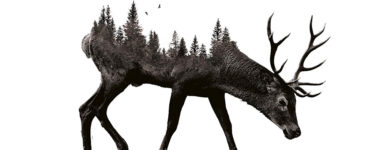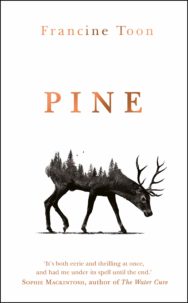‘It captured my imagination that Dornoch was the last place in Britain to execute a witch [in 1727].’
David Robinson speaks to Francine Toon about the inspiration and setting behind her first novel, Pine.
Pine
By Francine Toon
Published by Doubleday
If they ever make a film of Pine, Francine Toon’s debut novel, it will probably begin much the same way as her book. The opening shot will establish the setting: a village in a wooded Sutherland valley, with adults shepherding oddly dressed children from door to door. It’s Hallowe’en. Of course it is. When else would you want to set a Gothic novel?
We don’t need to notice too much about the villagers, but we’ll let the camera pan on their faces just long enough for us to recognise them in later scenes: a ceilidh, perhaps, or the hunt for a missing teenager. Most of the time, though, the film will focus on a ten-year-old girl called Lauren and try to work out what she makes of the world. Take, for example, that skinny woman in a white dressing gown she has just caught a glimpse of from the passenger seat of her dad’s car as they approach the village.
‘Who’s that?’ she asks him.
‘Who’s what?’ he replies, turning up the music.
Who that was, and whether or not Lauren has in fact just seen a ghost, and if so why, and is the subject of her novel. Toon doesn’t believe in the supernatural herself, but writing horror or fear is, she says, like trying to write humour – ‘you need the equivalent of comic timing to make sure that a “reveal” lands in the right way. I’m fascinated by that process and how other writers like Shirley Jackson or MR James managed it.’ Or, she could have added, the contributors to Haunted Voices, the anthology of Scottish Gothic storytelling, from new imprint Haunt Publishing, which she has just started reading.
Toon is already well regarded as a poet and has worked for the past three years as editor at Sceptre, where she has shepherded a number of novels to publication, including Starling Days by Rowena Husayo Buchanan, which was shortlisted for the Costa Novel of the Year. When it came to choosing the setting or the protagonist for her own novel, however, she didn’t have any hesitation.
Its Sutherland village, she says, ‘is a blend of two places I lived – Rogart, a hamlet north of Dornoch, where we moved up to from London when I was about eight, and Clashmore, where we lived beside a really big pine forest.’ After the bustle of London, where she couldn’t even play in the street, the potential freedom to explore that this part of Scotland offered made a deep impression. It was at Rogart, a place so remote that you might even spot wildcats there, that she imagined the woman in white making her first, fleeting appearance.
Dornoch added something else to the mix. ‘It captured my imagination that Dornoch was the last place in Britain to execute a witch [in 1727]. She was called Janet Horne, so in the book the valley is called Strath Horne, although I imagined it in a slightly more New-Age way. At Royal Dornoch golf course, next to the 17th hole, there’s what they used to call the Witches’ Pool, where witches were “swum”, ie tortured and drowned… So there’s something in the air, and even if you don’t believe in the supernatural, it’s easy to imagine that there actually was something out there. . . ’
Perhaps to the young Francine the supernatural seemed just that bit more real than it had in England. Certainly, she noticed, there seemed to be more interest in ghost stories in Scotland. It wasn’t just learning to recite Tam o’ Shanter, or the ghostly ‘urban myths’ even the teachers delighted in telling at school. ‘They really scared me, those stories, but then I got to telling them myself, so even from the start there’s been an element of horror about my storytelling.’
She had originally intended to make Lauren the same age as she had been when she first arrived in Scotland, but she then made her a bit older, so she could better understand the adult world. Lauren is also English, and is bullied because of it. Was that something else drawn from life?
‘It wasn’t as bad for me as it is for Lauren,’ Toon concedes, pointing out how friendly the villagers and most of the children had been. ‘But when I was ten, I had this growth spurt and was so much taller than the other children, and I was this strange child from London and had an English accent, so . . . On the other hand, it did give me that outsider’s perspective.’
Ah yes, the outsider’s perspective. How often do you find it when you interview authors that apparently easy explanation for why they became writers in the first place? With Toon, you wonder how much her writing owes to the shock of that move to Scotland when she was eight. Is that why she is able to convey such a clear sense of the multiplicities of middle childhood, the way Lauren can adore the simplicities of Frozen at exactly the same time as working out the psychological complexities of reading Tarot cards, or how she can be one minute worrying about her father’s health, the next belting out Bat Out of Hell as a Halloween ‘treat’?
Changing countries, standing out from the crowd. Just being different. Sometimes that can be all it takes to set you out on the road to becoming a writer. It can be many other things too. For Stephen King, the master of the modern gothic horror novel, it was coming across a box of fantasy paperbacks from the 1940s that belonged to the father he never knew.
In 2008, having studied classics at Edinburgh University and worked for Chambers Dictionary, Toon headed back to England for a job at Hodder & Stoughton, where among other things she was editorial assistant to Stephen King’s UK editor. She’s keen to emphasise that she never worked directly with Maine’s horror maestro, but all the same she would certainly have read his books in proof form before they appeared in the shops.
That’s how I read Pine too, in a proof copy which her publisher promises ‘unites the gloom of the modern gothic with the pulse of a thriller’. That’s fair enough, I thought, when I finished the book, but the blurb went on to claim that the book was set ‘in a place that feels like the end of the world’. If Sutherland really did feel like the end of the world, I can’t imagine Toon wanting to return. Yet a couple of days after our chat, that’s exactly where she was heading, back to see friends. She might have an outsider’s perspective, but she’s got an insider’s one too.
Pine by Francine Toon is published by Doubleday, priced £12.99
ALSO IN THIS ISSUE

 Jane Eyre: A Retelling
Jane Eyre: A Retelling
‘I adored Jane’s righteous fury, her wild passion, her sense of injustice: I absolutely identified w …

 David Robinson Reviews: Pine
David Robinson Reviews: Pine
‘It captured my imagination that Dornoch was the last place in Britain to execute a witch [in 1727]. …













